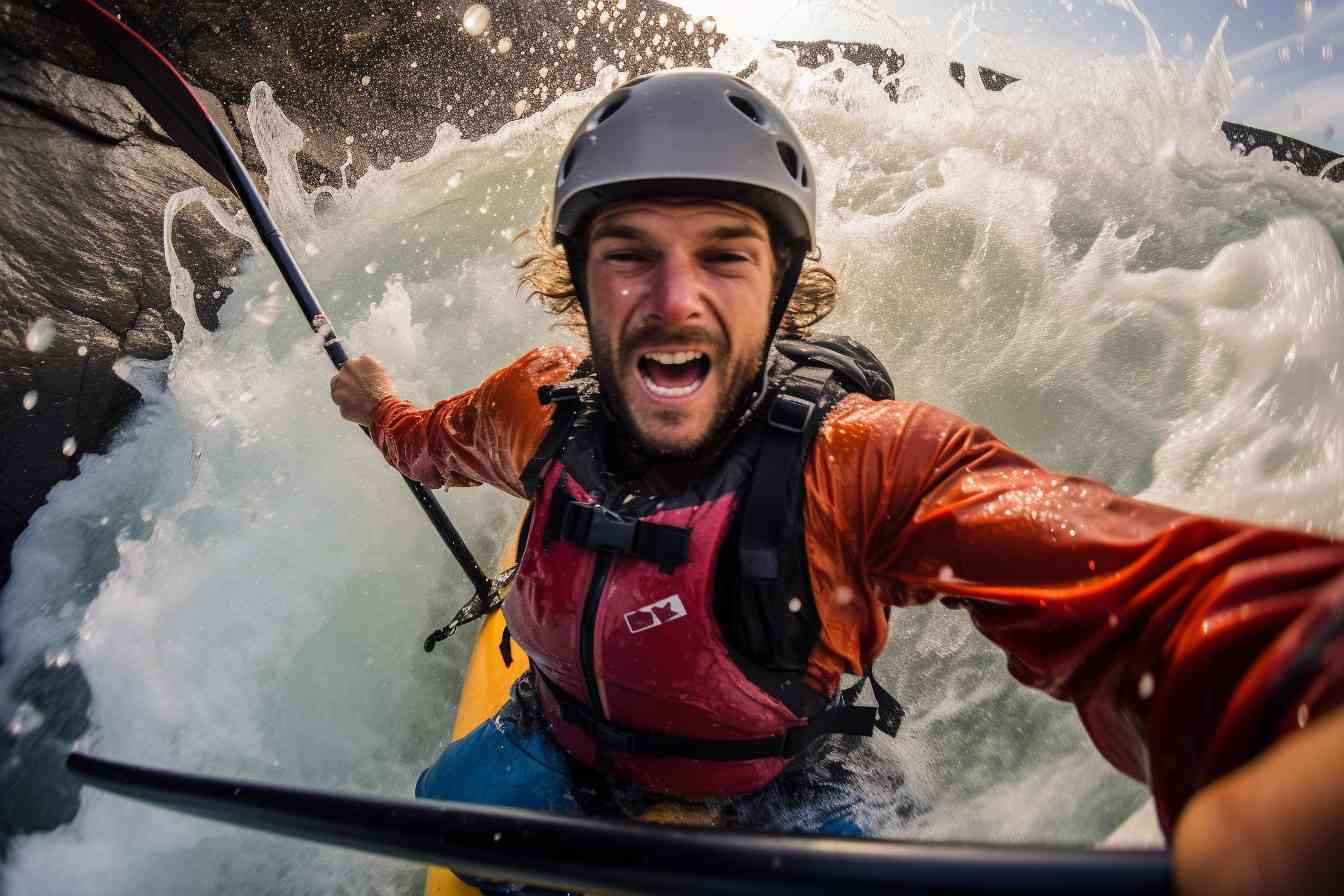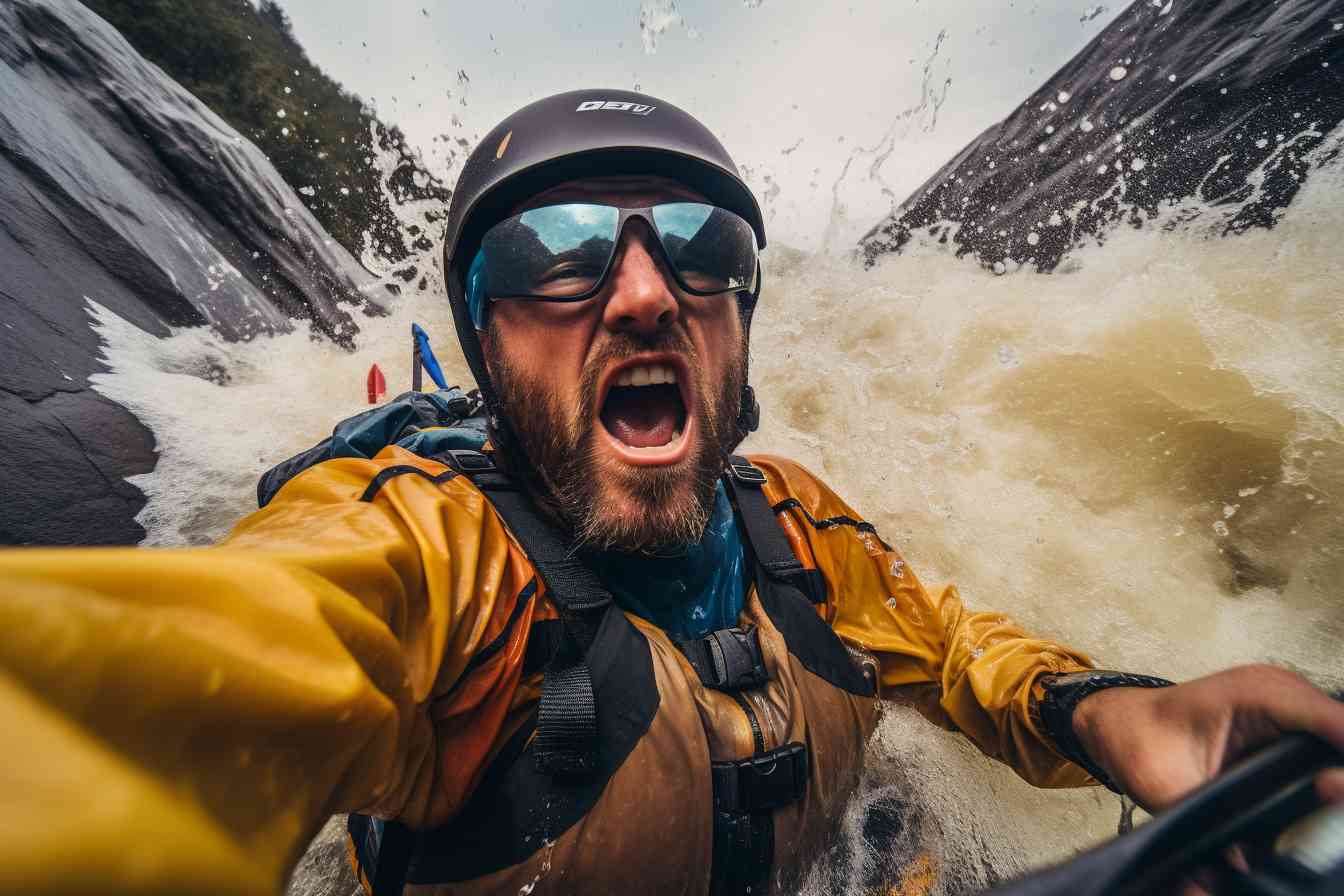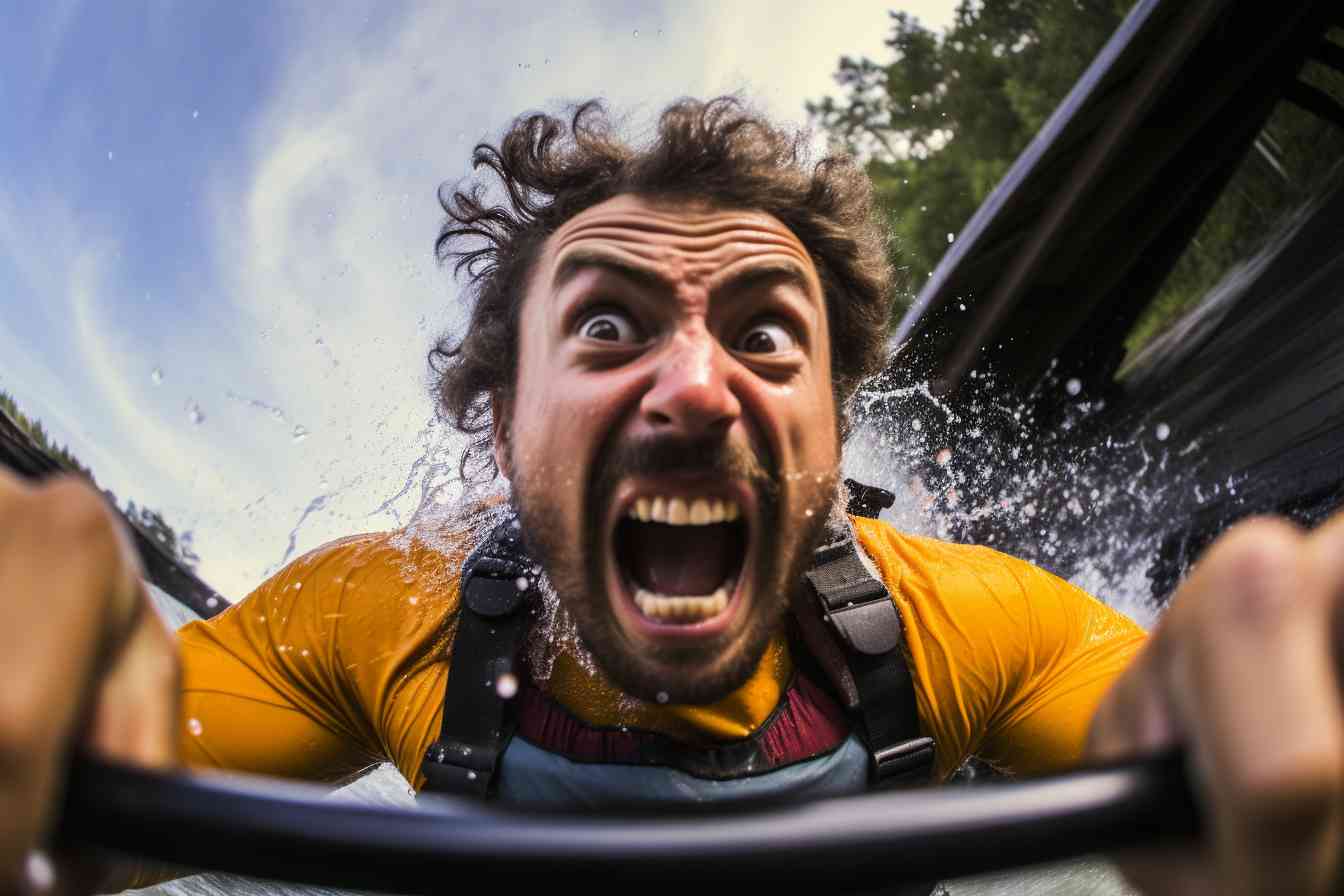Intro: Can You Get Stuck Upside Down In A Kayak

As an experienced kayaker, I have heard plenty of folks express their fears about getting stuck upside down in a kayak. Why not? It’s a pretty daunting idea, ain’t it? But let me reassure you, it’s not as bad as you may have conjured it up in your mind, alright?
So, the answer is yes and no. Seriously—yes, you can find yourself flipped upside down while kayaking. It’s called a capsize, and while that might sound utterly terrifying, it’s a regular part of the kayaking adventure. Capsizing happens even to the most experienced kayakers. It’s not a matter of ‘if’, but ‘when.’ It’s part of the game, pals.
However, the ‘no’ part comes in with ‘getting stuck.’ Being trapped upside down in your kayak is highly unlikely, especially if you’ve been trained correctly. Good training always includes lessons on how to handle a capsize situation. You learn to exit your kayak underwater by releasing the spray skirt that keeps you in place. And if you’re really good, you’ll figure out how to do an Eskimo roll—that’s a technique where you right your capsized kayak without getting out!
Remember, kayaking, like anything else, is all about practice and preparation. With the right training and mindset, an upside-down scenario will be nothing more than a little hiccup on your water adventure. In short, don’t let the fear of ‘getting stuck’ stop you from having a splash!
What Happens If You Flip Over In A Kayak?

Goodness me, let’s talk about something that can be intensely scary to a lot of folks — flipping over in a kayak. Now, I must admit, it does sound terrifying, doesn’t it? But you know what they say: knowledge is power. So, let’s kick the panic to the curb and dive right into what actually happens when you flip over in a kayak.
Now, you may be picturing a sight straight out of a Hollywood action flick — yourself, trapped in an overturned kayak, struggling for breath. But that’s not quite the case, my friend. When you capsize, your natural buoyancy — yes, we all have it, even if you don’t believe yourself to be a strong swimmer — will pop you right out of the kayak.
However, I must highlight — this can be a disorienting experience. Your kayak is flipped, you’re in the water, and there may be a moment where you don’t know which way is up. But hang in there, stay calm! Remember, panic is your worst enemy in such situations.
Flipping over in a kayak is much more common than you may think. It’s all part and parcel of kayaking! Heck, I’ll even go so far as to claim it’s part of the fun! But, all jocularity aside, this doesn’t mean you take it lightly. Always have and wear a life jacket. Learn the proper techniques to right your kayak.
Now, I must emphatically state, practice is key! Learning and practicing capsize drills in a controlled environment could make the whole experience less hair-raising. So, if you ever find yourself upside down in a kayak, don’t fret! You’re not stuck! Just follow the training you’ve had, stay calm, and right yourself back up. Adventure is out there my friends, on the kayaking trail!
How Do You Get Back In Kayak If It Flips?

Well, isn’t this a pickle we’ve all imagined ourselves in? You’re out on the water, enjoying the serenity, when all of a sudden – splash! – your kayak flips. Everything’s topsy-turvy, you’re bobbing up and down, and there’s a real sense of fear rising. Now, be mindful that you won’t be “stuck” per se – your body isn’t trapped in the kayak. However, it can feel like it when you’re in icy waters and panic sets in. That’s why it’s imperative you know how to right your kayak.
Now, let’s chat about what to do when your kayak does a somersault. Initially, stay placid. It’s crucial not to panic. You’ve got your life vest on (right?), so you’ll float. Then, if you’re strapped in, release your spray skirt. This is usually done yanking on a readily accessible loop.
From there, it’s a game of pat-a-cake with your kayak. You’re going to want to give the bottom of your kayak a good, firm slap. This’ll hopefully flip the boat back upright. If this doesn’t work, you’ll need to use your paddle or even your hands to turn the kayak back around.
After the kayak is right-side-up, come up for some air if you need to. Then, position yourself next to the kayak in the water and ready yourself for a big pull. You’ll want to hoist yourself onto the kayak, keeping your center of gravity as low as possible to prevent another spill. Next, swing your legs into the boat, sit back down, and there you are – no longer upside down!
This takes practice on dry land or in a shallow pool before you can nail it out in the wilderness. Don’t beat yourself up if you can’t do it on your first try – persistence and preparation are key. Stay safe out there!
Is It Ok To Store Kayaks Upside Down?

Oh boy, you wouldn’t believe the number of times I’ve been asked this – “Is it okay to store kayaks upside down?” And the short answer, my friend, is a resounding yes! It’s not just okay, but often it’s recommended… especially for those high-quality kayaks you’ve been saving your pennies for.
Let’s delve a little deeper into this, shall we? When you flip your kayak upside down for storage, it reduces the chance of any water retention inside the hull. Trust me, stale water inside a kayak? Not exactly a picnic! More importantly, it retains the shape of the kayak. Imagine coming back to your kayak to find out it’s more banana-shaped than kayak-shaped because of the weight it has been bearing. You wouldn’t want that, would you?
Additionally, storing your kayak upside down can also protect it from external damages. It acts like a natural shield against the harsh weather elements, particularly the harmful UV rays. Yes, that’s right! Much like your skin, kayaks need protection from the sun too. Extended exposure can lead to the material becoming brittle and cracking over time.
I get it, you might be worried about the seats and the deck rigging, but trust me, most are built to withstand being stored upside down. If you’re really concerned, consider removing any attachments that might be vulnerable.
Chemme, I’ve paddled, and been stuck upside down, more times than I’d like to admit. But in terms of storage, upside down is the way to go! Just don’t forget to secure it properly, you don’t want your pride and joy rolling off into the sunset now, do you?
How Do You Not Flip Over In A Kayak?
Well, let me share my two cents on this, folks! You see, a good balancing act can help you prevent the flip in a kayak. It’s essential to maintain an even keel, – that is, to center your weight as much as possible. Leaning too far to one side is a sure-fire way to tip over.
Now, keep in mind, the stability of your kayak can also be influenced by its design. A wider hull offers more stability, while a narrower one increases speed but can be a bit wobbly. So, depending on your kayaking goals and skill level, the type of kayak you choose could have a significant influence on whether you flip over or not.
Using your paddle correctly can also help maintain your balance. When you’re rowing, it’s crucial to keep the strokes smooth, consistent, and close to the kayak. No wild swings, alright? Disturbing the water abruptly can knock you off balance, especially in rough waters.
Another thing to consider is what you’re doing with your body. Proper posture, my friends, is a game-changer! Sit up straight, and keep your torso rotated forward. Also, remember that moving your hips and lower body independently from your upper body can help with stability – a little trick known as the ‘hip snap’.
So, to cut a long story short – balance, correct paddle technique, and proper posture are your secret weapons against flipping over in a kayak. Practice makes perfect, of course, but with these tips, you’ll be one step ahead. Happy kayaking!
Final Verdict
Alright, so you’re curious, can you get stuck upside down in a kayak? I’m here to tell ya. The answer is yes, but it’s not as frightening as it sounds. It’s a situation called a “kayak roll” where a kayaker is temporarily flipped upside down in the water.
Now, it’s important to note that getting stuck is not the norm. In fact, skilled or even moderately experienced kayakers can right themselves relatively easily using a technique known as an “Eskimo roll”. Trust me, I’ve been there.
If you’re new to kayaking, practicing this move in a controlled environment – say, a pool or a calm lake – can help you gain confidence. I remember my first Eskimo roll like it was yesterday, the adrenaline, and the satisfaction that came from righting myself above water again.
Before you start worrying, let me reassure ya – getting permanently stuck upside down in a kayak is extremely rare. Most kayaks are designed to be stable and easy to flip back upright. Sure, you might get a nose full of water if you’re not prepared, but a little water never hurt anyone. And remember, safety equipment, such as a personal flotation device and helmet, are paramount.
So, get out there on the water! And rest assured, even if you do find yourself upside down, it’s unlikely to be for long. After all, Kayaking is all about adventure and, sometimes, that involves a bit of rolling. Keep calm, remember your training, and you’ll be just fine.
To wrap up my spiel here, yes, you can technically get stuck upside down in a kayak. But no, it’s not a death sentence and yes, there are techniques and equipment to help you right yourself. Remember, practice makes perfect, and safety should always be your top priority. Happy kayaking!
Frequently Asked Questions
1. Can you actually get stuck upside down in a kayak?
Absolutely, it is possible to get flipped and stuck upside down in a kayak. This is especially common when kayaking in turbulent waters where the motion of the water can easily flip the kayak over.
2. What should I do if my kayak flips upside down?
Don’t panic! You should try to escape the kayak by pushing yourself out using your hips and leaning forward, which will allow you to swim freely. Once out, refloat your kayak and use the “T-Rescue” method to get back in.
3. How common is it to get stuck upside down in a kayak?
Honestly, it’s not that common. Most kayaks, especially recreational models, are designed to be very stable and are unlikely to tip over. However, it can happen, particularly in more challenging conditions or during whitewater kayaking.
4. How dangerous is getting stuck upside down in a kayak?
It can be dangerous if you’re not prepared. You could panic, which might make the situation worse, or you could inhale water. That’s why it’s essential to know how to get out of the kayak quickly and in a controlled manner.
5. What kind of training can help me if I get stuck upside down in a kayak?
You might want to consider taking a kayaking safety course. These courses often teach things like the “wet exit” (getting out of an overturned kayak), and how to roll (flipping the kayak back upright while staying in it). It’s a lifesaver!
6. Are there specific types of kayaks where getting stuck upside down is more likely?
In most cases, sea and whitewater kayaks are more likely to flip over due to their design and the environments where they are used. So yeah, their design factors in this.
7. How can I prevent my kayak from flipping upside down?
Make sure to distribute the weight evenly in your kayak, don’t make sudden movements that could destabilize the kayak, and pay attention to your path, especially in rough waters.
8. Can I get stuck upside down in a kayak even if I’m wearing a life jacket?
Yes, a life jacket won’t prevent you from flipping over or getting stuck underwater, but it will keep you afloat once you get out of the kayak.
9. Does my physical fitness play a role in getting stuck upside down in a kayak?
Certainly! Good balance, core strength, and swimming skills can help you stabilize your kayak and handle being upside-down underwater.
10. Any tips for kayak beginners to avoid getting stuck upside down?
Yes, first, consider booking a guided tour or lessons. Second, always wear a life jacket. Third, learn and practice safety measures like wet exit and kayak roll. Lastly, it’s better to start on calm waters. Happy kayaking!

